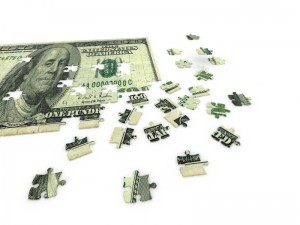We each have a money puzzle. It is that riddle we often call a budget. The place where available financial resources are fit together with needs and wants, goals and dreams. For many, budget has become a bad word because it signifies worry and stress, marital conflict, and failure. Personally, I’m not too fond of the black and white, plus or minus world of budget-making, but I do love money puzzles.
Whether you have a budget already in place or you want to create a money puzzle for the first time, here are some tips to keep it fresh, make it fun, and most of all, put the pieces together.
- The Big Picture: Occasionally my husband and I like to put a puzzle together. The first thing we do is study the picture on the front of the box. We notice color changes, buildings, and any other stand-out features we can use to place pieces where they belong. A money puzzle needs a big picture too or you won’t know where the pieces go. Imagine what you want your financial tapestry to look like when you are all done. Examine your goals and dreams so you know what’s important. Remember to study the picture on the box often to remind yourself what it looks and to see new details that help you find the right pieces.
- Edge Pieces: My husband is very methodical, especially when it comes to puzzles. (Really, you should see him organize the pieces by shape!) The edge pieces must be put together first. This creates the boundary for the rest of the picture. The edge pieces of the money puzzle are pieces like income, expenses, and must-haves (like giving to charity or saving for a house). Once these are in place, the other pieces fill in the middle.
- Shapes and Colors: When we fill in the middle pieces, we usually work on sections at a time to find pieces with a common color that might belong together. For instance, if the image we are creating has sky space, we look for blue pieces. Finding the financial themes in your money puzzle will help you collect the pieces you need to work on a section. Themes from my money puzzle include education, kids’ stuff, and entertainment.
- Close but Not Quite: Puzzle pieces have similar shapes and sizes, so it is easy to put two similar pieces together that aren’t quite a match. When we realize the pieces don’t belong, we can simply take them apart and try again. For example, I may say I’m only going to spend $100 a month on food for my family of six, but for us that’s just unrealistic. That amount of money for that item may seem like a great fit at first, but a single trip to the grocery store will show me I put the wrong pieces together.
- Getting Stuck: When I’m working on a corner of a puzzle and I just can’t seem to find the pieces I need, I try three things. First, I get a new perspective by rotating the puzzle to look at it sideways or upside down. The new perspective can help me see details I was missing. Second, I work on a different corner. Sometimes I just have to walk away or focus on another part of the puzzle. Third, I copy my husband and try every single puzzle piece in one or two spots until I find the ones that fit. It can be a long process of trial and error, but eventually I find the match.
- Wrong Puzzle: Sometimes we get started on a puzzle only to find the pieces don’t match the picture on the box. Resources change. Goals change. Situations change. The vision you have for your finances may change too, and that’s okay. When we find ourselves with the wrong puzzle, it’s time to change the box – or start a new puzzle. There’s nothing more frustrating than trying to fit a piece into the wrong puzzle (or get to the end and find a piece is missing).
- Completing the Puzzle: We set up our puzzles on a large board or a table we won’t have to use for a while because we know it’s going to be a long project. We can usually get the outline of edge pieces put together in an hour or two, depending on the size of the puzzle. But beyond that we know it will take days to nest each piece in the right spot. Money puzzles are a process too. Some sections have obvious matches while others take years of trial and error to find the right fit. Don’t get discouraged because your money puzzle is unfinished. Enjoy it as a work-in-progress.
The beauty of the money puzzle is in the image it creates. It’s not about balance sheets. It is an opportunity to create a piece of art through how we invest our resources. Whether we invest in organic food, music lessons, 401k accounts, or vacations, how we design our money puzzle says a lot about who we are and what we value. Sometimes I like the way my money puzzle turns out and sometimes I know it’s time for a do-over with a fresh puzzle. Either way, the money puzzle lets me engage my creativity and imagination to see the picture in the pieces.
I want to hear from you! What does your money puzzle look like?
